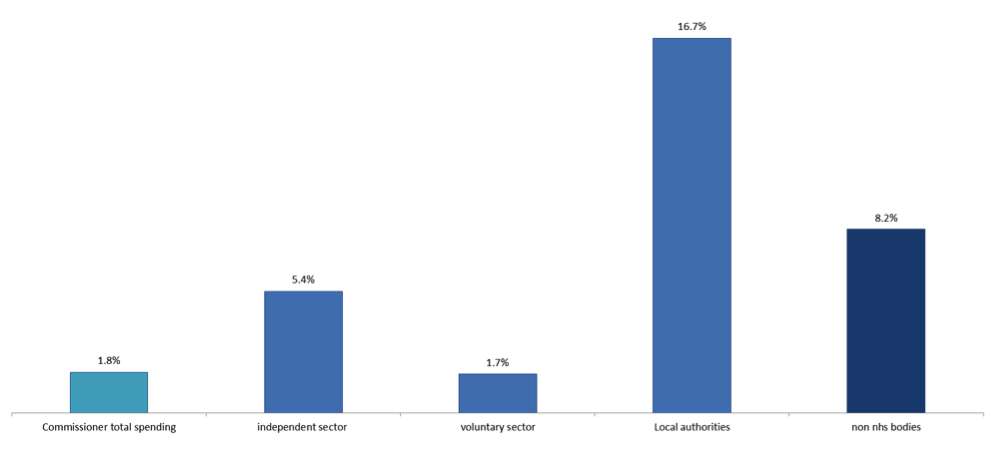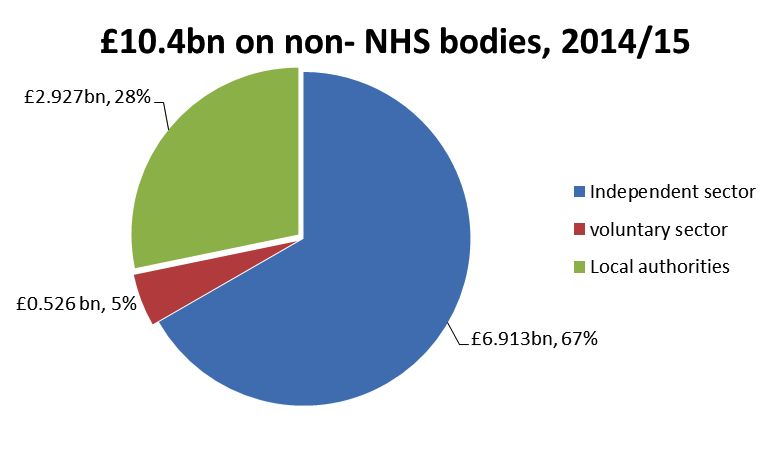Spending on non-NHS bodies for the provision of NHS-funded health care is always a "hot" topic in England. The question of how much is actually spent on care provided by private sector bodies is a source of great debate. This is due to the lack of availability and transparency of these figures, combined with the lack of cohesion by the main NHS bodies when data is published.
To illustrate this, let’s look at some recently published figures. The Department of Health published a figure of £10.4bn for spend on non-NHS providers for the delivery of NHS-funded care in 2014/15. The very next day NHS England published a figure of £11.6bn. After further investigation I found the DH figure includes prior-year payments on continuing care, while NHS England’s numbers also include purchase of social care from private providers. So the figures are both ‘technically’ correct, but publishing like this could be confusing for those not in the know. This confusion distracts from the major point that spending on non-NHS providers is increasing at a faster rate than total spending on services.
When we focus on the DH numbers, which provide a breakdown by type of provider, we see that spending on non-NHS providers – the sum of spending on local authorities, voluntary and independent (or private) providers – increased by nearly £1bn from 2013/14 to 2014/15. That’s an annual increase of 8.2% in real terms, greater than the increase in total spend on services (2.4% in real terms).
This sharp annual increase is partly explained by the greater role that local authorities now play in the provision of health care. After the 2012 Health and Social Care Act, parts of the public health budget were transferred over to local authorities for them to provide more services. In the last financial year, spending on health care provided by local authorities increased by 17% in real terms from £2.5bn in 2013/14 to £2.9bn in 2014/15 (figure 1).
Figure 1: Annual change from 2013/14 to 2014/15, (2014/15 prices)

Of the £10.4bn spent on non-NHS bodies, about two-thirds is accounted for by the independent sector (figure 2). This has risen at a much faster rate than total spend on services by commissioners, 5.4%, compared to 1.8% respectively in real terms. So the independent sector now accounts for 7.1% of the total commissioner’s spending (6.3% of total NHS spend) compared to 6.8% in 2013/14 (6.1% of total NHS spend). Of this, the most rapid increase in spending on the independent sector was for the provision of community health services where the independent sector accounted for £1 for every £5 spent on community health services in 2012/13. It would be interesting to know if this trend continued into 2013/14 and 2014/15, but the data at this level of detail are not available – this information is no longer collected and little is known about the quality of service provided in that sector.
Figure 2: Non-NHS spend

So how much of total spending is on care provided by non-NHS providers? The DH published figure is 9.4% of total health spending in 2014/15 (up from 8.9% in 13/14). But total health spend includes running costs for DH and other arm’s length bodies. Perhaps a fairer way to look at proportion spent on non-NHS providers is as a share of commissioners’ spend. With this measure, the number rises to 10.6% in 2014/15 (from 10.0% in 2013/14). In other words, about 10% of the budget set to provide health care to the population is spent on care provided by non-NHS bodies.
The available data show that commissioners have increasingly purchased health care from non-NHS providers. The independent sector now plays a much greater role in the provision of NHS-funded care. Whether the independent sector should be or shouldn’t be involved in the provision of health care has been an ongoing debate, but the fact is that little is known about the value for money and the quality of service provided.
With the NHS’s budget under pressure, and about half of NHS providers in deficit at the end of March 2015, efficiency in resource allocation becomes crucial for the sustainability of the health care sector. A deeper understanding of the areas where spending is increasing is becoming essential. NHS providers are now under increased scrutiny but we still know little about the area of spending increasing at the fastest rate. The lack of information around type, cost and quality of services provided makes it increasingly difficult to monitor and evaluate the efficiency and quality of the sector. More data, transparency and consistency from the leading national bodies are needed in order to fully understand the implications and the role of independent providers in the provision of NHS-funded healthcare.




















